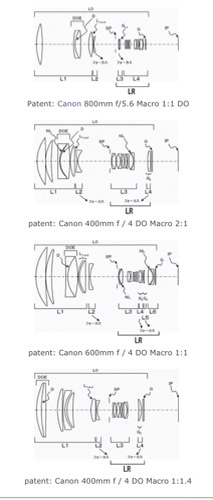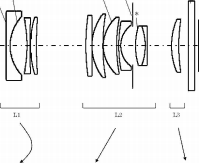Four New Canon Telephoto Lens Patents: 2 x 400mm f/4, 600mm f/4 and 800mm f/5.6, all with macro)

Once more Egami (translated) spotted interesting new patents filed by Canon. A 400mm f/4 DO macro 1:1.4, a 400mm f/4 DO macro 2:1, a 600mm f/4 macro 1:1 and an 800mm f/5.6 DO macro 1:1. All lenses feature diffractive optical elements (the DO in the naming)
[via Egami]Self-interpretation and summary, Patent Documents
- Release Date 2012.12.10
- Filing date 2011.5.23
- Focal length f = 788.34mm
- Fno. = 5.80
- 2ω = 3.14 ° angle of view
- Image height 21.64mm
- 486.00mm length lens
- BF 110.67mm
- β = -1.02
- (The second and third group is for the focus) consists of four groups of positive and negative polarity
- (One side of the image, such as the most protective glass) x 17 lens elements in 12 groups composed
- Maximum effective diameter 135.92mm
- Two two-sided aspherical
- DOE 1 surface
- One fluorite
- Three Super UD glass
- One low-dispersion glass
- Focal length f = 400.00mm
- Fno. = 4.12
- 2ω = 6.20 ° angle of view
- Image height 21.64mm
- 300.00mm length lens
- BF 55.00mm
- β = -2
- (For the second focus group 2,4) consists of four groups of positive and negative positive negative
- (One side of the image, such as the most protective glass) x 19 lens elements in 12 groups composed
- Maximum effective diameter 97.09mm
- Five 5-sided aspherical
- DOE 1 surface
- Two fluorite
- 1 UD glass sheet
- One low-dispersion glass
- Focal length f = 585.00mm
- Fno. = 4.12
- 2ω = 4.24 ° angle of view
- Image height 21.64mm
- 350.00mm length lens
- BF 55.00mm
- β = -1
- (For the second focus group 2,4,5) group configuration 6 positive negative positive positive negative
- (One side of the image, such as the most protective glass) 22 sheets 13 groups lens configuration
- Maximum effective diameter 142.00mm
- Four four-sided aspherical
- DOE 1 surface
- Two fluorite
- 1 UD glass sheet
- Focal length f = 390.99mm
- Fno. = 4.12
- 2ω = 6.34 ° angle of view
- Image height 21.64mm
- 256.40mm length lens
- BF 62.35mm
- β = -0.7
- (For the second focus group 2,4) consists of four groups of positive and negative positive negative
- (One side of the image, such as the most protective glass) x 16 elements in 12 groups lens configuration
- Maximum effective diameter 94.90mm
- Four four-sided aspherical
- DOE 1 surface
- 2 UD glass sheets
- Two low-dispersion glass
- Easy to shorten the minimum focusing distance
- AF is faster
- Large variations in aberrations
- Many aberration occurs at close range
- With a focus group of two or more
- However, optimization of the parameter is mandatory
- In the macro range of 0.5 times more difficult to correct aberrations
- Shortening of the total length can be
- Distance of the lens group becomes narrow, the range of movement of the focus group will be limited
- Group before and after the group of positive and negative
- Inner Focus (and the second group, one of the rear group)
- By setting multiple focus groups, perform the division of sensitivity, the amount of movement
- In short travel distance, is focused on the short-range











